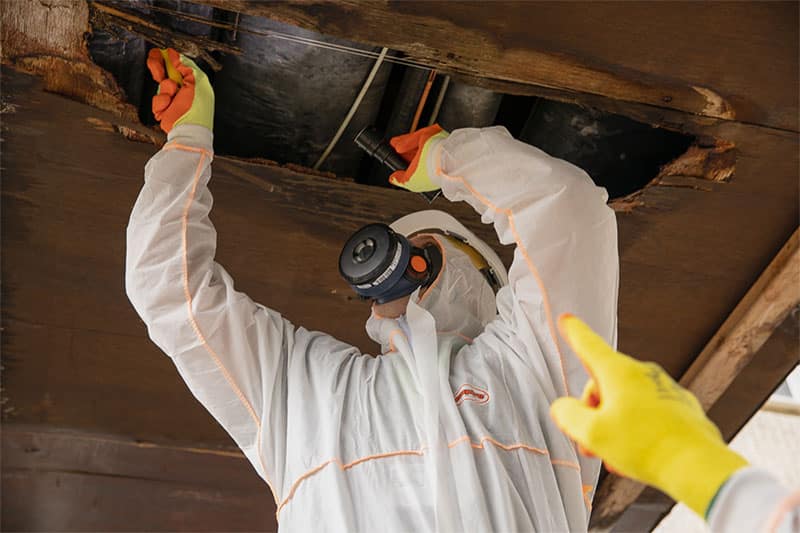My asbestos survey was done prior to 2010: is it out of date and non-compliant?
The management of asbestos is a critical aspect of ensuring the safety of commercial, public, and residential buildings that date back to before the year 2000. With the fibrous silicate mineral having only been entirely banned in the UK in late 1999, there is a strong likelihood of any premises from prior to that time still containing asbestos-containing materials (ACMs) – a reflection of how extensively this now-notorious substance was once used.
As set out by Regulation 4 of the Control of Asbestos Regulations 2012 (CAR 2012) – the overarching asbestos legislation in Great Britain – there is a “duty to manage” asbestos for individuals in charge of maintenance for non-domestic premises.
As part of this duty, dutyholders must take reasonable steps to determine whether there are ACMs in the given building. If ACMs are indeed present, the dutyholder will also be expected to find out information about the amount, location, and condition of those materials.
We have written in the past here at Oracle Solutions about the fact that CAR 2012 doesn’t explicitly refer to an asbestos survey being needed in order to find out the aforementioned information. However, it is often extremely difficult to gather the information that the “duty to manage” requires, without arranging to have an asbestos survey undertaken.
In this sense, it can be considered that an asbestos survey is, indeed, essentially mandatory in order to comply with the legal requirements under CAR 2012.
There is, however, another issue to consider for some dutyholders: what if the property for which they are responsible has had an asbestos survey conducted on it in the past, but this was prior to 2010? If this describes your situation, it is crucial to understand the current standards and whether your asbestos survey meets today’s stringent regulations.
In this article, we will explore why an asbestos survey carried out before 2010 is no longer compliant, and what you need to do to ensure your property’s safety and compliance with the present asbestos regulations.

Why are pre-2010 asbestos surveys non-compliant?
Professional asbestos surveys carried out before 2010 followed the UK Health and Safety Executive (HSE)’s previous guidance in relation to Surveying, sampling and assessment of asbestos-containing materials, under the series code MDHS100. This document was published in July 2001.
In 2010, however, more detailed and stringent guidance – as set out in the publication Asbestos: The survey guide, with the HSG264 series code – was published. The changes in this guidance reflect an enhanced understanding of asbestos risks and the need for more comprehensive management strategies. A second edition of this document was published in 2012.
The HSG264 guidance significantly heightened the standard of best practice for asbestos surveys. One major change over the years has been the transition from Type 1, Type 2, and Type 3 surveys to the two principal types of asbestos survey that exist today. These are the management survey, which used to be known as a Type 2 survey, and the refurbishment or demolition survey, which was formerly called a Type 3 survey.
If, then, you have a Type 1 asbestos survey for your building, this will no longer be valid under the present regulations, CAR 2012. Furthermore, many Type 2 and Type 3 surveys from prior to the publication of HSG264 are shown to be insufficient once a new asbestos survey has been carried out on the premises.
Key differences between MDHS100 and HSG264
Below, we have outlined the important distinctions to know about between the asbestos surveys that were standard according to the now-outdated MDHS100 guidance, and those complying with the post-2010 HSG264 guidance.
1. Survey types and scope
With regard to the asbestos survey types that adhered to the MDHS100, pre-2010 guidance:
- The Type 1 (Location and Condition) Survey was aimed at locating ACMs based on visual inspection, and assessing their condition. It was non-intrusive, being limited to accessible areas, and did not involve any sampling – only visual identification.
- The Type 2 (Standard Sampling, Identification, and Assessment) Survey entailed locating ACMs and confirming the presence of asbestos through sampling. It was typically non-intrusive, although suspected ACMs were sampled. These samples were collected for laboratory analysis in order to confirm asbestos was present.
- The Type 3 (Full Access Sampling and Identification) Survey focused on comprehensive identification of ACMs prior to demolition or major refurbishment. It was fully intrusive – involving destructive inspection – and extensive sampling was carried out in order to identify all ACMs.
As for the situation with asbestos surveys under the HSG264 guidance:
- The asbestos management survey is aimed at helping with the management of ACMs during the normal use of a building. This survey is generally non-intrusive, unless intrusion becomes necessary in order to access hidden materials. It involves minor sampling, alongside the assessment of materials to confirm the presence and condition of asbestos.
- The asbestos refurbishment or demolition survey is, as its name indicates, focused on locating all ACMs that could be disturbed during planned refurbishment or demolition work. It is a fully intrusive and destructive survey, accessing all areas where ACMs may be present, so that they can be identified and managed. Comprehensive sampling ensures the identification of all ACMs in the surveyed area.
2. Survey methodology
The methodology used for asbestos surveys conducted in line with the pre-2010 MDHS100 guidance was somewhat different to that which has applied under the HSG264 guidelines since 2010:
- In the case of asbestos surveys under MDHS100, only somewhat general methodology was used. The guidance consisted of broad guidelines, which allowed for variability in survey practices. Asbestos surveys subject to these guidelines relied heavily on visual inspection and the surveyor’s judgement, with the sampling methods not being as standardised as came to be the case under HSG264.
- Asbestos surveys under HSG264 have been subject to comparatively detailed methodology, with clear and prescriptive guidelines ensuring consistency. There are well-defined procedures for visual inspection, sampling strategies, and risk assessments. Greater detail is provided, for example, in relation to the number of samples and the areas to be sampled.
3. Surveyor competence and training
This is another area in which there have been notable differences between MDHS100-era asbestos surveys, and the more recent surveys subject to the HSG264 guidance:
- With regard to asbestos surveys adhering to MDHS100, the use of trained personnel was recommended, but there was a lack of specific criteria. While the guidelines emphasised the need for knowledgeable personnel, accreditation requirements were not clearly stated.
- Asbestos surveys in accordance with HSG264 have been subject to more rigorous competence standards. The guidelines set out defined and clear standards, with detailed criteria in relation to qualifications, experience, and the training of surveyors. HSG264 also encourages the use of UKAS-accredited organisations and emphasises continuous professional development.
4. Survey reporting
The standards for this aspect of asbestos surveying also differ between MDHS100 and HSG264:
- The MDHS100 document provided general guidance on what to include in an asbestos report. Variation in formats, however, led to inconsistencies in report quality. Reports adhering to this guidance focused on the presence and condition of ACMs, but there wasn’t so much emphasis on standardised detail as came to be the case under HSG264.
- Under the HSG264 guidance from 2010 onwards, a standardised reporting format has been expected from surveyors. Specific formats were mandated for consistency, and it was necessary for photographs, plans, and diagrams to be provided with reports. All in all, HSG264 greatly helped to make asbestos reports more accurate, transparent, and reliable, thereby allowing for better-informed asbestos management decisions.
The importance of up-to-date asbestos surveys
Having a genuinely up-to-date asbestos survey in place for your property is crucial for several reasons:
- Regulatory compliance: arranging to have a new asbestos survey conducted at your site will give you the peace of mind of knowing your property adheres to current asbestos regulations. This will also enable you to avoid legal and financial penalties.
- Health and safety: an up-to-date asbestos survey will give you the information about the present situation at your site that will enable you to take the necessary steps to protect occupants and workers from asbestos exposure risks.
- Insurance: a current asbestos survey will help ensure your property is “insurable”, given that insurers may not accept an outdated survey.
- Property value: having a new asbestos survey conducted will help ensure your property meets safety standards, thereby maintaining or even increasing its value.
Steps to ensure compliance with current asbestos regulations
Taking the following actions will help to make sure you are on the right side of present UK law when it comes to any asbestos survey for your property, and the associated asbestos management:
- Arrange a new asbestos survey. If your premises’ latest asbestos survey was carried out prior to 2010, schedule a new survey following HSG264 guidelines.
- Hire competent surveyors. You should ensure your property’s new asbestos survey is undertaken by UKAS-accredited professionals possessing the required qualifications and experience.
- Review the survey report. A new asbestos survey being carried out, also means a new report being produced. So, you should check that this survey report includes all the required elements such as photographs, detailed plans, risk assessments, and recommendations.
- Implement the recommendations in the new report. Following the recommendations that the new asbestos report sets out will enable you to manage any identified ACMs in a safe and responsible manner. The management steps that you take may encompass a combination of repair, removal, and/or encapsulation.
- Regularly review your asbestos management plan. By regularly reviewing and – whenever necessary – updating the asbestos management plan for your building, you can further help to ensure ongoing compliance and safety.
Conclusion: a pre-2010 asbestos survey isn’t enough to ensure safety and compliance
In summary, an asbestos survey conducted prior to 2010 will not comply with the current HSG264 guidance and is therefore outdated and non-compliant.
To ensure that your property and its occupants remain safe, as well as to satisfy present regulatory standards, it will be essential to arrange for a new asbestos survey to be undertaken by competent professionals. This will provide a comprehensive and reliable assessment of asbestos risks, enabling you to manage the dangers on the basis of detailed and up-to-date information. That, in turn, will greatly help maintain a safe environment.
By understanding and addressing the shortcomings of your building’s latest asbestos survey if it was conducted before 2010, you can help ensure your premises is safe, compliant, and well-managed.
To learn more about our own expertise in asbestos surveys here at Oracle Solutions, and to request a free and fast quote for any of our asbestos services, please don’t hesitate to contact us via phone or email.

Written by Jess Scott
Jess Scott has been an all-round asbestos consultant since 1996. That’s nearly 3 decades of asbestos knowledge. He spends his time sharing that knowledge with the team at Oracle and with their clients. Jess's goal is, and always has been, to use my expertise in helping people to comply with the law. This legal compliance ultimately helps to protect everyone from the harmful effects of asbestos. Jess has acted as an asbestos expert witness in legal cases and is involved in many asbestos educational activities throughout the UK.
